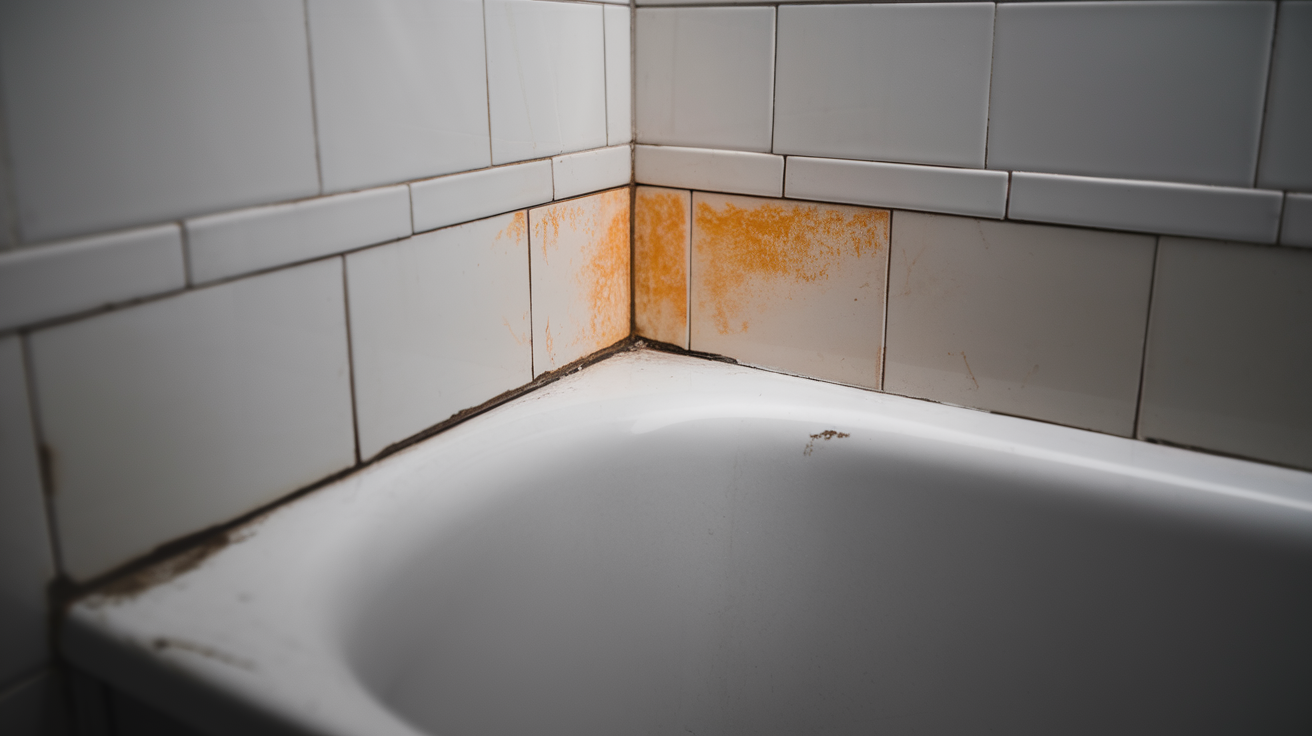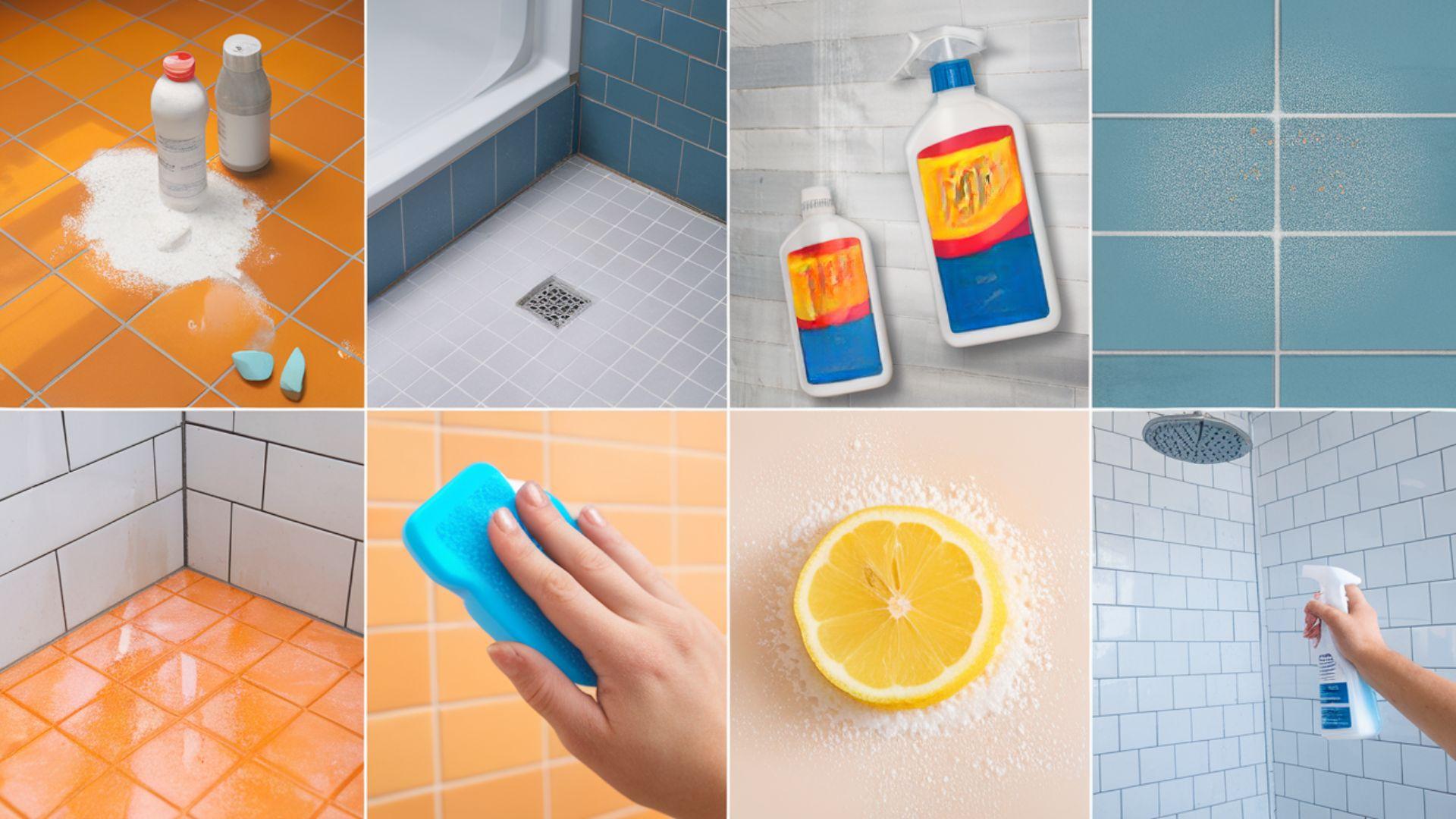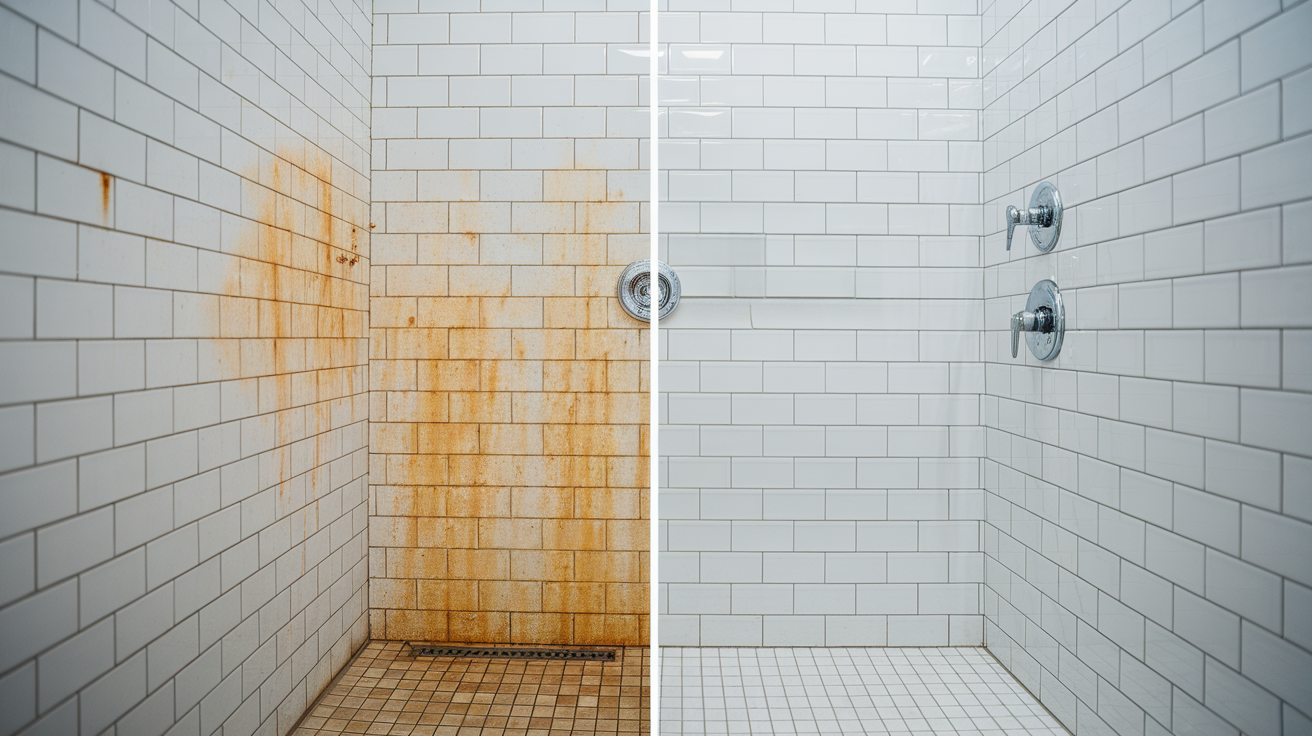Do you see orange stains in your shower? Maybe they’re on the tub, the tiles, or even the curtain.
I’ve been there too. I tried scrubbing and scrubbing, but those stains just wouldn’t go away. It’s frustrating, and definitely not something you want to look at every day.
Orange stains in the shower are more common than you might think. From what I’ve learned, they usually come from three main things: iron in the water, soap scum, or bacteria that love growing in damp places.
The good news? You can fix it. You don’t have to toss out your shower curtain or spend a ton of money on fancy cleaners.
With the right product and a bit of effort, I’ve been able to get my shower looking clean again, and you can too.
In this blog post, I’ll explain what causes orange stains, how I clean them, and how I prevent them from coming back. It’s easier than you might expect!
What are the Orange Stains in Your Shower?

If you’re noticing orange spots, streaks, or rings in your shower, it’s not just a little dirt or leftover shampoo.
These stains can show up on the tub, the tile walls, around the drain, or even on your shower curtain. So what are they?
Most orange stains are caused by minerals, soap, or bacteria that get left behind after water dries. The stains build up over time, especially in warm, wet places where moisture hangs around.
1. Iron in Your Water
Some homes have hard water, water with lots of minerals like iron. This is common if you use well water.
When iron in your water touches the air, it turns into rust. That rust sticks to your tub, shower floor, or walls and makes orange or reddish-brown stains.
Even if the water looks clean, small bits of iron can still leave marks over time.
2. Soap Scum and Iron Working Together
Soap scum is the white or cloudy film that forms when soap mixes with minerals in hard water.
If your water also has iron in it, the soap scum can turn orange. This mix clings to the shower walls, glass doors, and corners, making it even harder to clean off.
3. Bacteria (Serratia Marcescens)
This is a type of bacteria that shows up as a pink or orange film. It grows in warm, wet places, like the corners of your shower, on tiles, around the drain, or in the rubber or silicone caulking.
It’s not usually dangerous, but it can be gross and spread quickly if not cleaned.
4. Rusty Pipes & Cheap Fixtures
Old metal pipes can rust on the inside without you seeing it. That rust travels with the water and leaves behind orange stains, especially around your showerhead or faucet.
If your stains keep coming back even after you clean them, rusty pipes might be the reason. Low-quality metal parts in your shower, like the showerhead, faucet, or screws, can rust when they get wet often.
That rust runs down with the water and causes orange marks on the tub or walls.
5. Shampoo and Conditioner Residue
Some hair products, especially darker-colored shampoos or ones with minerals, can leave behind orange or reddish buildup.
If you don’t rinse your shower well after washing your hair, those products can stain the surfaces over time.
6. Dirty or Contaminated Cleaning Tools
Using old sponges or brushes can spread rust, bacteria, or mildew instead of cleaning. These germs stick to grout lines, corners, and tile surfaces.
Over time, they leave behind orange stains. Always rinse cleaning tools well, let them dry fully, and replace them often, especially if they smell bad or look worn out.
7. Standing Water in the Shower
When water doesn’t drain properly, it pools in spots like corners or flat shower shelves. This creates the perfect place for soap scum, rust, and bacteria to build up.
Over time, these areas can develop orange stains that are hard to clean. Keeping your shower dry helps prevent this kind of stain from forming.
Are Orange Shower Stains Harmful?
Most of the time, orange stains in your shower aren’t dangerous. Minerals, soap scum, or harmless bacteria often cause them. But that doesn’t mean you should ignore them.
Even if they’re not toxic, orange stains can make your shower look dirty and feel gross.
If bacteria like Serratia marcescens cause the stains, they can become a health risk over time, especially for people with allergies or weak immune systems.
Bacteria grow fast in wet places, and the longer you wait to clean them, the worse they get.
Also, if you leave orange stains untreated, they can soak into grout, caulking, or porous tile. This can cause permanent stains or even damage the materials, making them crack, peel, or break down.
Cleaning them early and often helps keep your shower safe, clean, and in good shape.
How to Remove Orange Stains from Your Shower

Not all orange stains are the same, so the way you clean them depends on what caused them. Here are seven ways to clean orange stains, from rust to bacteria to soap scum buildup.
1. Vinegar and Baking Soda
Mix white vinegar and baking soda to make a thick paste. Spread it over the orange stain and let it sit for 15–30 minutes.
Scrub with a soft sponge or cloth, then rinse well. This combo breaks down rust and soap scum without using harsh chemicals. It’s safe for most tubs, tiles, and shower walls.
2. Iron Removers Like Iron OUT or CLR
For stains caused by rust or iron in the water, use a cleaner like Iron OUT or CLR. Spray the product on the stain or follow the label instructions.
Let it sit, then scrub gently and rinse well. Always wear gloves, and don’t mix with other cleaners. These are stronger products, so use them carefully.
3. Bleach-Based Cleaner
Orange stains caused by bacteria can be treated with a bleach-based bathroom cleaner. Spray it on the affected area and let it sit for 10 minutes.
Scrub with a soft brush or sponge and rinse well. Since bleach has strong fumes, open a window or run a fan to keep the air fresh.
4. Hydrogen Peroxide
Hydrogen peroxide is a gentle, bleach-free way to clean orange stains caused by bacteria or mold.
Pour it into a spray bottle and spray the stained areas. Let it sit for 10–15 minutes, then scrub and rinse.
It helps remove the pink-orange film without strong smells, and it’s safe for use on most surfaces.
5. Magic Eraser or Scrub Sponge
A damp magic eraser or a soft scrub sponge can help scrub away soap scum and mineral stains.
Use gentle pressure to avoid damaging tile or tub surfaces. These tools work better when used with a vinegar spray or bathroom cleaner.
They’re good for tough corners and buildup that regular wiping doesn’t remove.
6. Lemon Juice and Baking Soda
Squeeze lemon juice over the orange-stained spot, then sprinkle baking soda on top. The fizzing helps loosen rust and buildup.
Let it sit for 5–10 minutes, then scrub gently and rinse with warm water. This natural method smells good and works well for light stains on tubs, sinks, and tile.
7. Shower Cleaner Spray (Prevention Tip)
To stop orange stains from coming back, spray your shower with a daily or weekly cleaner.
These sprays help prevent mineral buildup, soap scum, and bacteria. Just spray the walls, door, and corners after each use; no scrubbing needed.
This is a fast and easy way to keep your shower clean between deep cleanings.
How to Prevent Orange Stains from Coming Back
Once I got rid of the orange stains, I didn’t want to deal with them again. A few simple steps I take to keep them from coming back are:
1. Install a Water Softener or Iron Filter
If your water has a lot of iron or minerals, it can leave behind orange stains. A water softener or iron filter removes these from the water before they reach your shower, helping stop rust stains from forming.
It’s a bigger fix, but it works well if stains keep coming back, no matter what you clean with.
2. Wipe Down Shower Walls and Doors After Use
After every shower, use a squeegee or towel to wipe water off the walls, tiles, and shower door.
This keeps water from sitting too long and cuts down on moisture, soap scum, and bacteria. It only takes a minute, but doing it regularly helps stop orange stains before they even start.
3. Improve Ventilation to Reduce Moisture Buildup
Bacteria and mold love damp places. If your bathroom stays wet or steamy for too long, orange stains have a chance to grow.
Open a window, run the bathroom fan, or leave the door open after a shower to help everything dry faster. Less moisture means fewer stains.
4. Clean Regularly with Vinegar or Bathroom Cleaner
A quick weekly cleaning can keep orange stains away. Spray your shower with white vinegar or a store-bought bathroom cleaner, then rinse after a few minutes.
This helps break down soap, minerals, and germs before they build up. If you stay ahead of the mess, you won’t have to scrub as hard later.
5. Seal Grout to Keep Out Moisture and Minerals
Grout between your tiles can soak up water and trap iron or soap scum, causing deep stains. A grout sealer creates a barrier that keeps water and stains out.
I tend to apply the sealer every year or as needed to protect my shower. This small step makes a big difference in keeping stains away.
When to Call a Professional
- The stains come back quickly: You clean, but the orange stains return in a few days. A pro can test your water to determine if there’s a deeper problem.
- There’s mold or water damage: If you see mold, smell something musty, or notice peeling paint or soft spots, you may leak. A professional can find and fix it.
- You have natural stone or special surfaces: Strong cleaners can damage materials like marble or soft tile. A pro knows how to clean these safely without scratching or staining them.
Conclusion
Orange stains in the shower are common and usually come from iron in the water, soap scum, or bacteria. They might look bad, but they’re usually easy to clean.
Using simple tools like vinegar, baking soda, or a gentle scrubber can help remove the stains. For tough spots, try a rust remover or bleach-based cleaner.
The best way to keep your shower clean is to wipe it down after each use, clean it weekly, and keep the area dry and well-ventilated. If stains keep coming back, it might be time to call a professional.
I’ve found that with a little regular care, a shower can stay fresh, bright, and free of stubborn stains.

